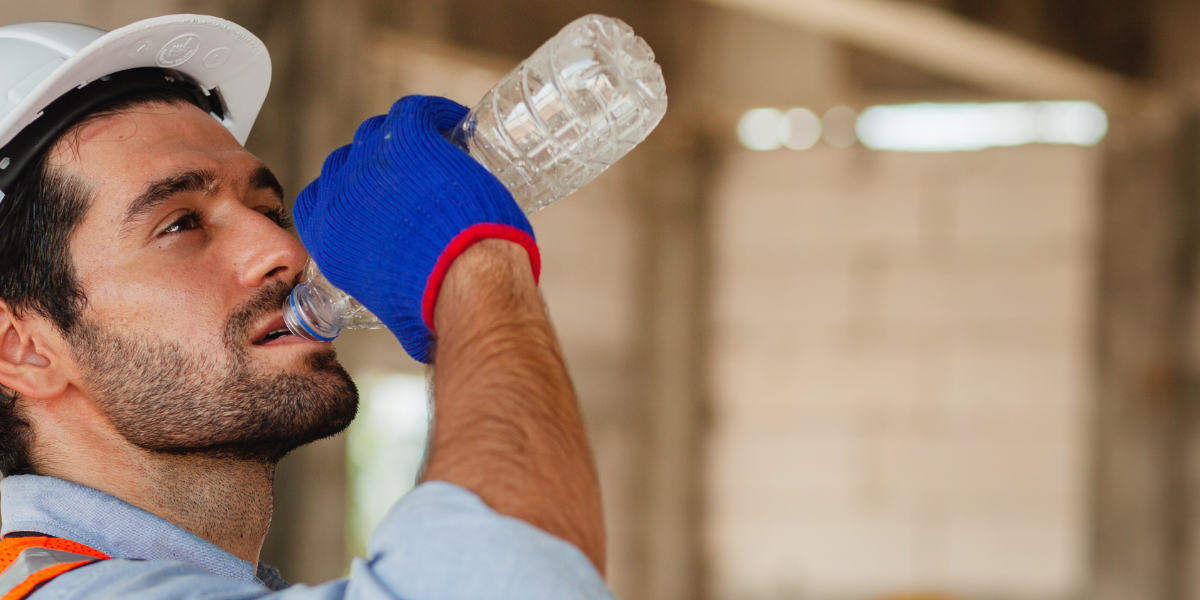
This article was published in the 2024 Excavation Safety Guide.
Summer of 2023 was reported to have the hottest months ever recorded on earth. Unfortunately, these conditions will continue to get worse as the frequency, intensity, and duration of heat waves increase[1]. Climate change is a major public health priority that places many at risk for life-threatening heat injuries and illnesses. Workers are particularly vulnerable to heat-related injuries as they often engage in heavy physical exertion for prolonged hours[2–5]. Moreover, occupational heat stress is a combination of environmental heat, physical activity, and personal protective clothing, which taken together, exacerbates the level of heat strain placed on the body[3,6].
Unfortunately, there are no federal standards to protect the health and safety of workers. The Occupational Safety and Health Administration (OSHA) has created a National Emphasis Program on Outdoor and Indoor Heat Hazards, which is a nationwide enforcement mechanism to inspect workplaces for heat-related hazards. In other words, OSHA can perform heat-related inspections on high-risk worksites to make sure workers are not susceptible to preventable heat-related injuries, illnesses, and fatalities. Therefore, it is your responsibility as an occupational and environmental health and safety professional to ensure heat safety practices are in place and workers are protected during times of high heat exposure.
So, where do you start?
Here are some considerations and strategies to implement within your heat stress management plan.
Written Heat Safety Policies and Procedures
Like any hazard, it is important to have clear and written heat safety policies and procedures. During an inspection, this may be the first item OSHA personnel will ask to see. Successful heat safety policies and procedures include the following elements (but not limited to):
- Heat Safety Education (onboarding and annual training)
- Prevention Strategies (heat acclimatization, work to rest ratios, environmental monitoring, etc.)
- Emergency procedures for heat-related medical emergencies (i.e., exertional heat stroke)
Your plan must include what you will do to prevent heat-related injuries and illnesses from happening in the first place (i.e., prevention strategies). But it must also consider what happens when all systems fail and someone suffers an exertional heat-related illness. As no health and safety plan is 100% failproof, there needs to be clear guidance that outlines what workers should do in the event of a heat-related emergency. An exertional heat illness that is life-threatening is exertional heat stroke. The signs and symptoms of exertional heat stroke include extreme hyperthermia (greater than 105°F), altered consciousness, disorientation, confusion, vomiting, staggering, decreased performance, profuse sweating, dizziness, and irritability/combativeness. Extreme hyperthermia, altered consciousness, disorientation, and confusion are characterized as diagnostic criteria for exertional heat stroke[7]. If you suspect that someone is succumbing to exertional heat stroke, you must act quickly to reduce their core temperature as quickly as possible. This requires aggressive body cooling within 30 mins of collapse[7]. The gold standard method to reduce core temperature and to treat exertional heat stroke is aggressive, whole-body cold-water immersion[8].
Heat Safety Prevention Strategies
To reduce the risk of exertional heat illnesses, it is key to have evidenced-based prevention strategies in place. Here are a few key prevention strategies to include in your heat stress management plan.
Hydration
Dehydration has been reported to increase a rise in core temperature (i.e., increase risk of heat-related illness), negatively affect performance, productivity, and mood[9]. Maintaining a hydrated state during work can improve your workers’ health and safety while preserving or improving productivity. It is important to recognize that hydration is only part of the puzzle regarding risk of heat-related illness --- it is not characterized as the primary factor. Staying hydrated means paying attention to your body and using simple, hydration assessment tools to track your own hydration.
Urine Color
Workers should be encouraged to pay attention to their urine color before, during, and after work. A pale yellow or “straw-colored” urine color would be an indicator that the worker is adequately hydrated. The darker the urine, the more at risk an individual is to dehydration[10].
Thirst
When in a dehydrated state and body water content is low, fluid regulatory mechanisms in the body will initiate sensation of thirst as a signal to consume more fluids. It is important to note that the absence of thirst does not indicate the absence of dehydration[10].
Heat Acclimatization
Heat acclimatization is one of the most underutilized heat stress prevention strategies, but arguably, one of the most important. Most heat-related illnesses occur within the first three days of work, when workers are not accustomed to performing the level of physical exertion, sometimes in personal protective gear, in the heat[11]. Heat acclimatization is the gradual and progressive exposure to your physical work environment in the heat to achieve heat adaptations that allow workers to perform better in the heat[12]. Although there is limited research on industry-specific heat acclimatization protocols, NIOSH recommendations increase work by 10-20% over a 5-7 day period[13].
Environmental Monitoring for Activity Modification
As exertional heat illness is primarily driven by the metabolic heat generated by the individual, modifying the work to rest ratios is very effective to reduce risk. The industry standard for activity modification is the use of environmental monitoring, specifically Wet Bulb Globe Temperature (WBGT). WBGT uses four main meteorological components: air temperature, relative humidity, air velocity and radiant heat[14]. The National Institute for Occupational Safety and Health (NIOSH) and American Conference of Governmental Industrial Hygienists (ACGIH) provide WBGT-based activity modifications to protect workers during times of heat stress[13,15].
Margaret C. Morrissey-Basler, PHD can be contacted at mmorri17@providence.edu.
